Canary Wharf, London: Part Two
Yesterday I took you for a stroll around the very enticing Canary Wharf precinct which overlooks London.
Today we will look at the art which is a dominant feature of the area and which adds not only a touch of class but gives the precinct soul.
Let's start with a work by British sculptor Lynn Chadwick(1914–2003) who, in 1956 was chosen by the British Council as one of the lead sculptors to represent Britain at the XXVIII Venice Biennale. He was awarded the International Sculpture Prize, becoming the surprise winner and surpassing the favourite Alberto Giacometti, as well as César Baldaccini and Germaine Richier, and making him the youngest ever recipient of the prize. Following this critical esteem, Chadwick was talked of as the natural successor to Henry Moore as Britain's leading sculptor and artistic ambassador.1
And from where I stand Lynn Chadwick's scuptures certainly can rival a Thomas Moore which we will look at to conclude the post.
Couple on Seat LYNN CHADWICK, 2007 Bronze CABOT SQUARE (Courtesy of the Lypiatt Studios and Pangolin Editions.)
Lynn Chadwick (1914–2003) began his career as an architectural draughtsman but after World War II he took up sculpture. Couple on Seat is one of his later works. He produced many pieces with figures in various positions, following in the tradition of sculptor Henry Moore. Chadwick created a permanent exhibition of his work at his home at Lypiatt Park in Gloucestershire. An exhibition of his work was held in Canary Wharf in 2004.2
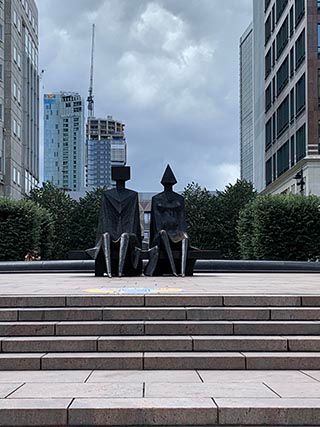
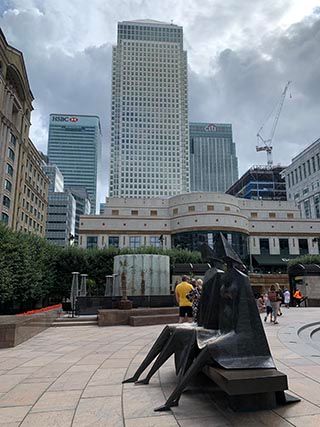
Works by American scuptor Helaine Blumenfeld particularly dominate...
Ascent HELAINE BLUMENFELD OBE, 2010 Bronze JUBILEE PARK
Ascent is Helaine’s most autobiographical work. In its union of two figures, we see a theme that she has often gone back to: by balancing intimacy with independence, we can create a unit of two people which has strength as well as tenderness. In the past, Helaine has explored this theme by tension, by forms which are breaking apart. Here, though, the emphasis is on harmony and support. Seen from one side, the female figure soars, but her ascent would not be possible without the strength of the figure that anchors her to the ground.2
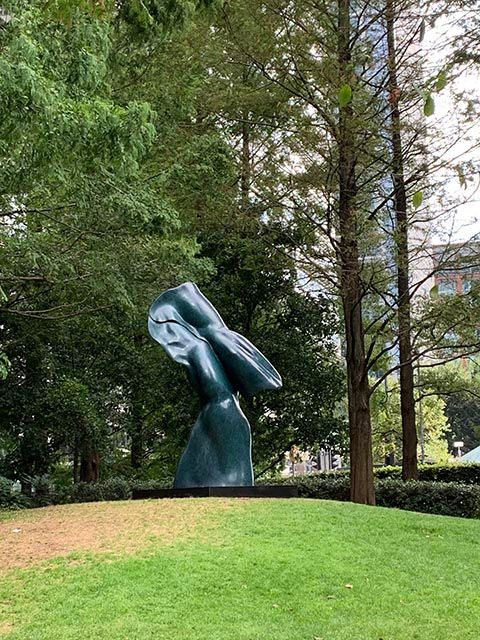
With over 100 art works throughout the area, Canary Wharf can boast being the largest collection of outdoor public art in London. 2 As those who run the show have emphasised:
What would life be without art? We don’t intend to find out. Canary Wharf is home to London’s largest collection of outdoor public art. Our collection of more than 100 pieces is a mix of stand-alone sculptures and integrated architectural works. Each piece is created by a highly-respected artist and together the collection is like a roll-call of modern artistic talent.2
To encourage you to experience the incredible art on your doorstep, our regular exhibition programme presents the work of artists from across the globe and our commitment to art has not gone unnoticed. We’ve won several awards including the Christie’s Award for Best Corporate Art Collection & Programme, and the award for outstanding contribution to Art in the Working Environment at the International Art & Work Awards.2
To go on a walk around the area please follow this link to be able to download a map showing the Art of Canary Wharf. Once on the site, scroll past the first image and you will see the link to the map at the end of the paragraph under the image.
Another two pieces by Helaine Blumenfeld are Venus and Fortuna.
Venus HELAINE BLUMENFELD OBE, 1993 Bronze JUBILEE PARK
Venus is an expression of a theme Helaine has been exploring throughout her career: Two Sides of a Woman. Essentially, it is a recognition of two different aspects of the female psyche, the side that is self-involved and self-sustaining and the side that depends upon outside influences. Every way you look at Venus you see another aspect of the figure’s character. From one side the woman is self-involved, feminine and maternal; as you go around the sculpture, just as the head thrusts back, you see an assertive warrior in power. 2
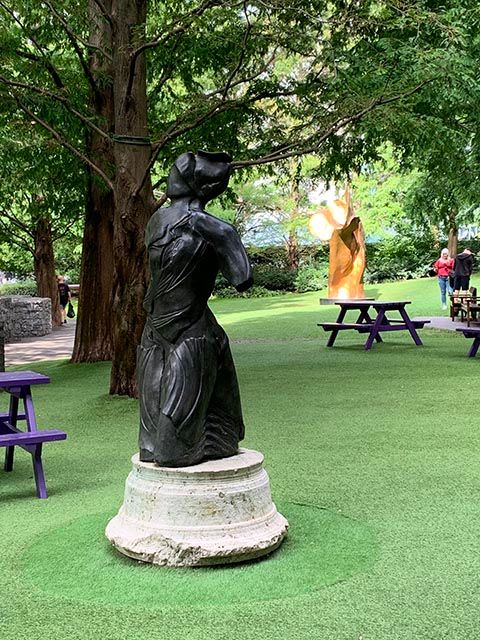
In the background (image above) is Fortuna also by Helaine Blumenfeld which:
...was a great challenge to create a monumental public sculpture like
Fortuna. Helaine wanted it to really connect with the large number of people who visit Jubilee Park everyday. She wanted Fortuna to say something about the human condition: turbulence, commitment, fragility, hope, inner strength, joy dependency, continuity and, above all, beauty. Helaine was delighted to see that people quickly identified the space by the sculpture – using it as a location for
meeting up or for sharing picnics. 2
To see a close up image of this sculpture please click here.
In a contrasting style is the Cosmic Stone which welcomes visitors to the Westferry Circus at Canary Wharf.
Sasso Cosmico by DO KÖNIG VASSILAKIS, 2007 Bronze, steel
Sasso Cosmico, which translated from the Italian means ‘Cosmic Stone’, has been installed in the peaceful garden at Westferry Circus. The reflective surface captures the surrounding planting, foliage, architecture, sky and clouds. In this way it provides a constantly changing manifestation of the seasons and the weather systems. König Vassilakis’ work is strongly influenced by the mythology and culture of ancient Greece and Rome. 2
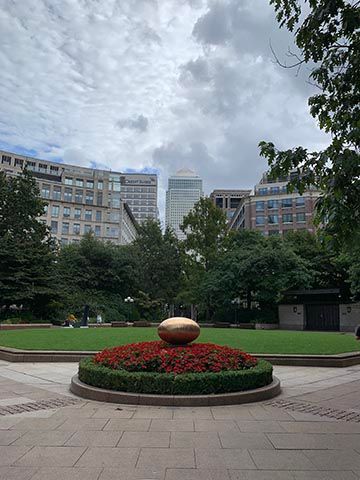
A more controversial art work is that created by Rachael Champion.
Temporary Retention Site for Atmospheric Particles RACHAEL CHAMPION, 2021 Steel Drums, plants MONTGOMERY SQUARE
Champion’s artworks explore the physical, material, and historical relationships between ecology, industry, and the built environment. The metal drums refer to the petrochemical industry, a conceptual link to London’s poor air quality. The sculpture addresses the issue of air pollution within our cities, encouraging biodiversity and to improve the quality of the air we breathe.2
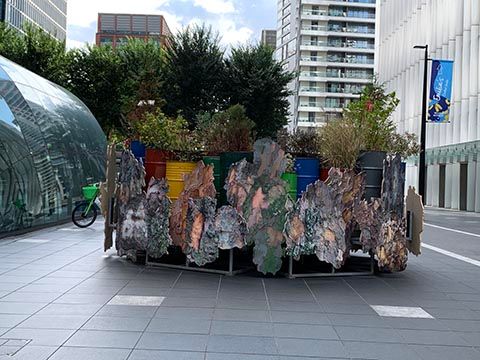
Continuing to showcase the distinctive works of Helaine Blumenfeld I really like this one - the visual and the concept!
Illusion HELAINE BLUMENFELD OBE, 2018 Bronze CABOT SQUARE
With Illusion, Helaine wanted individual forms which would give the impression
of extending beyond themselves. By recognising the importance of our own subconscious we can begin to have more meaningful relationships with each other and the world around us - relationships which are not static, they can be seen symbolically to change, as the parts of the sculpture are moved within the context of the whole. Helaine hopes that viewers will explore this idea by not only viewing, but by interacting directly with Illusion. The sculpture invites visitors to touch it, step into it and walk within and between its separate parts. 2
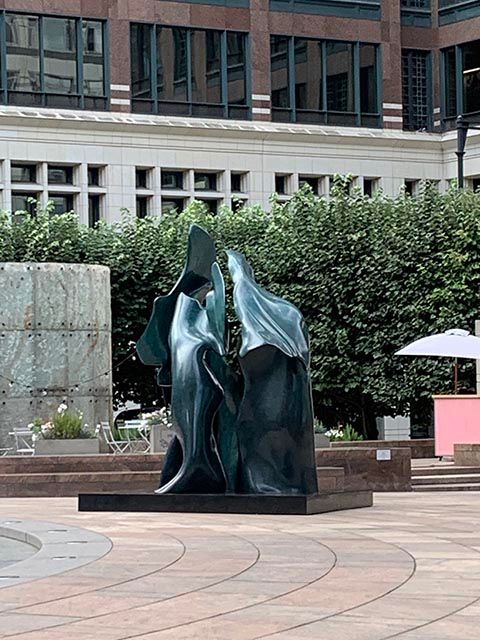
And again, this Blumenfeld in the perfect setting is very inspirational and challenging.
Taking Risks HELAINE BLUMENFELD OBE, 2019 Marble WESTFERRY CIRCUS
Taking Risks reflects the continuing importance of risk as an essential part of
Helaine’s creative process. Every aspect of creativity involves and requires risk. The ability to contradict her own forms is at the basis of every breakthrough Helaine has made as an artist. She feels she must always challenge her own aesthetic to go beyond the boundaries of what she has already created. There is no growth without change. In that sense each new work is a potential danger: a risk professionally as well as psychologically. Helaine never knows what to expect, she always begins without a starting point.2
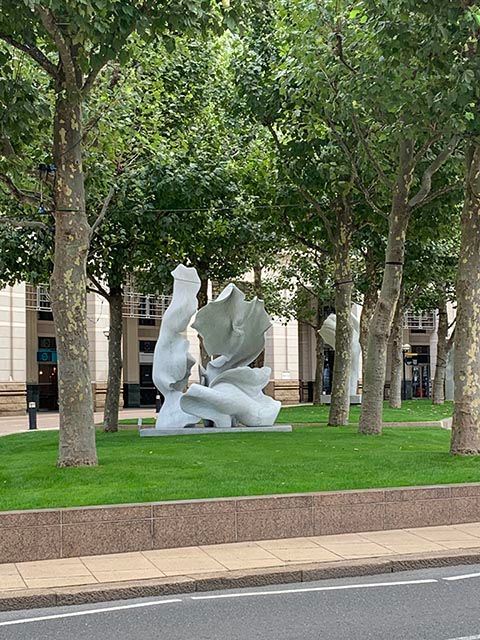
And signing off today I do have to acknowledge one of the greatest artistic talents of all time. For those of us who live in Melbourne, Victoria [Henry Moore] (https://en.wikipedia.org/wiki/Henry_Moore) introduced us to the world of sculpture when in 1960 the National Gallery of Victoria acquired a Draped Seated Woman - from the same mould as the sculpture found at Canary Wharf.
Draped Seated Woman HENRY MOORE, 1957–58 Bronze CABOT SQUARE
Henry Moore’s Draped Seated Woman was purchased in 1962 under London County Council’s Patronage of the Arts Scheme for the Stifford Estate in Stepney. In 1997, when the estate’s tower blocks were due for demolition, the sculpture was moved for safekeeping to Yorkshire Sculpture Park. In 2015 the new Mayor of Tower Hamlets pledged to bring the sculpture back to the borough and Cabot Square was chosen as its temporary home. The reinstatement of this important piece of the borough’s artistic heritage has been funded by Canary Wharf Group on behalf of London Borough of Tower Hamlets.2
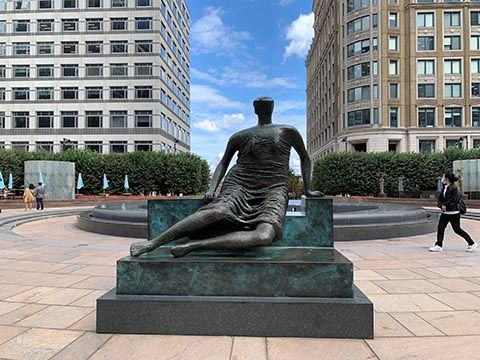
There are, as mentioned at the beginning of the post, over 100 pieces of art at Canary Wharf. If you would like to explore the art in more depth please click here.
Credits
1. en.wikipedia.org
2. canarywharf.com
